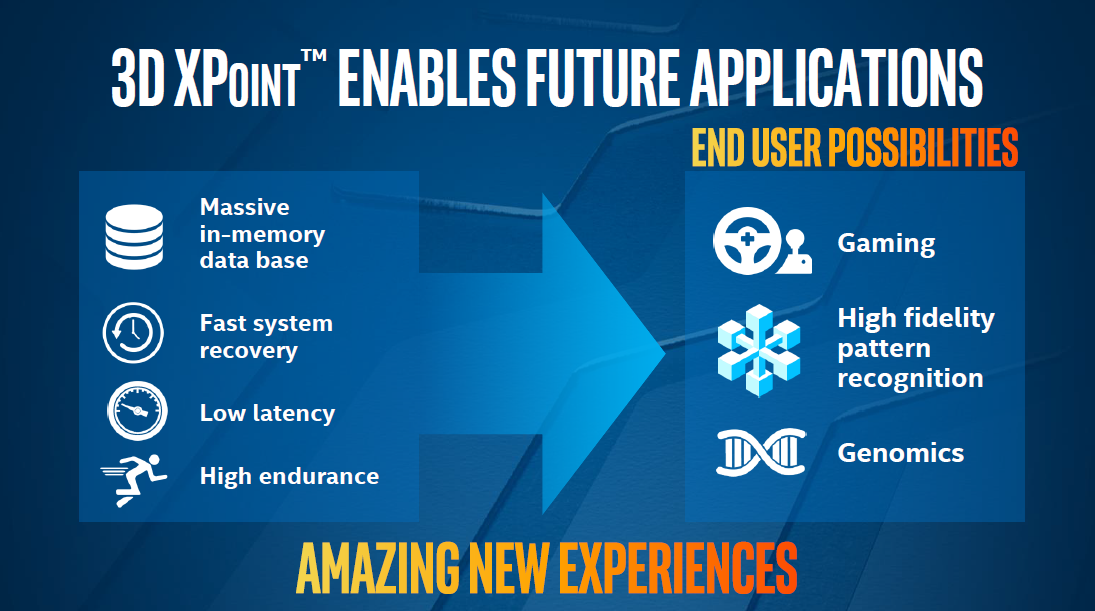Intel, together with Micron Technology, this year, will make a revolutionary breakthrough in non-volatile memory

Intel and Micron Technology have officially unveiled a new XPoint 3D non-volatile memory technology that will revolutionize the computing market. 3D XPoint is able to increase (up to 1300 times) the speed of operation of devices of various types, applications and services that require fast access to large amounts of data. For the first time in 26 years, 3D XPoint memory allows you to create a fundamentally new category of storage devices, replacing NAND technology.
This technology is up to 1.000 times faster and has up to 1.000 times longer service life than NAND memory. In addition, it has a 10 times higher density of components compared to DRAM memory.
')

Features of 3D XPoint technology:
Cross-shaped structure:
Perpendicular conductors unite 128 billion memory cells. Each memory cell stores 1 bit of data. This allows you to achieve high speed and high density.
Multilayer :
In addition to being located in a cross-shaped structure, memory cells are placed in several layers. The original technology allows you to store 16 GB per chip for two layers of memory. Future generations of technology will increase the number of layers for scaling capacity.
Using the selector :
DRAM memory uses a trasistor in each memory cell, which makes it large and expensive. Accessing and reading or writing to 3D XPoint memory cells is accomplished by changing the voltage value sent to each selector. This eliminates the need to use transistors, which increases capacity and reduces cost.
High-speed cells :
Due to the small cell size, high-speed selectors, low latency and fast writing, cells can switch states faster than any other non-volatile memory technology.
Benefits of 3D XPoint
The 3D XPoint technology combines all the advantages of memory technology available on the market. It is characterized by high performance and density of components, low energy consumption and an affordable price.
The delay value of hard drives and NAND memory is measured in microseconds, and 3D XPoint memory in nanoseconds (one billionth of a second).
The advantages of high speed 3D XPoint will be able to increase the comfort and normal users when working with a PC.
Those who know what it is, wait 15 hours while Autodesk Maya caches a file size of 400 GB, will appreciate the new type of non-volatile 3D XPoint memory that can work 1000 times faster than conventional SSDs with NAND memory.
Also, Intel believes that a new kind of memory will make a breakthrough in the recognition of patterns of various neuro networks, in the storage and processing of a huge amount of data, in the field of genomics, and other areas

“One of the most important problems in the world of modern computing technology is the long time it takes for a processor to access data in a storage system,” said Mark Adams, president of Micron. “A new class of non-volatile memory is a revolutionary technology that provides quick access to large amounts of data and allows you to create fundamentally new applications.”
Architecture
Innovative transistorless architecture creates a three-dimensional cross-structure, in which memory cells are located at the intersection of numerical lines and bit lines, which allows addressing in an independent order. As a result, data can be written and read in small sizes, which leads to a faster and more efficient read / write process.
First deliveries of 3D XPoint
Trial deliveries of products based on 3D XPoint technology for individual customers will begin this year. In addition, Intel and Micron are developing their own products based on this technology.
Presentation of XPoint 3D memory technology
Source: https://habr.com/ru/post/365969/
All Articles